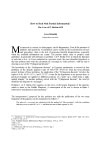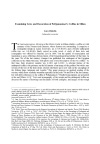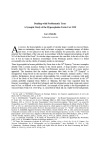Luca Miatello
« How to Deal with Partial Information? The Case of P. Berlin 6619 »
ENiM 9, 2016, p. 5-14.
 Dans le problème 1 du P. Berlin 6619, la dernière partie de chaque ligne est perdue. Dans cet article, j’indique les raisons pour lesquelles l’interprétation de la manière de procéder ne peut se fonder uniquement sur des raisonnements mathématiques, mais aussi sur l’expérimentation concrète d’hypothèses de reconstruction des phrases manquantes. L’analyse du texte du problème indique que les côtés d’un rectangle sont calculés avec l’objectif de montrer un cas du « théorème de Pythagore ». Une autre hypothèse, avancée au début du siècle dernier, est infirmée.
Dans le problème 1 du P. Berlin 6619, la dernière partie de chaque ligne est perdue. Dans cet article, j’indique les raisons pour lesquelles l’interprétation de la manière de procéder ne peut se fonder uniquement sur des raisonnements mathématiques, mais aussi sur l’expérimentation concrète d’hypothèses de reconstruction des phrases manquantes. L’analyse du texte du problème indique que les côtés d’un rectangle sont calculés avec l’objectif de montrer un cas du « théorème de Pythagore ». Une autre hypothèse, avancée au début du siècle dernier, est infirmée.
 In problem 1 of P. Berlin 6619 the final part of each line is lost. In this paper I indicate the reasons why the interpretation of the procedure cannot be based only on mathematical arguments, but also on concrete experimentations of hypotheses of reconstruction of the sentences and restoration of the missing parts. The analysis of the problem text indicates that the sides of a rectangle are calculated with the aim of showing a case of the “Pythagorean theorem”. An alternative hypothesis, advanced at the beginning of last century, is unsupported and unsuitable.
In problem 1 of P. Berlin 6619 the final part of each line is lost. In this paper I indicate the reasons why the interpretation of the procedure cannot be based only on mathematical arguments, but also on concrete experimentations of hypotheses of reconstruction of the sentences and restoration of the missing parts. The analysis of the problem text indicates that the sides of a rectangle are calculated with the aim of showing a case of the “Pythagorean theorem”. An alternative hypothesis, advanced at the beginning of last century, is unsupported and unsuitable.
 Consulter cet article (49255) -
Consulter cet article (49255) -  Télécharger cet article au format pdf (26500)
Télécharger cet article au format pdf (26500)
« Examining Texts and Decoration of Peftjauauiaset’s Coffins in Milan »
ENiM 11, 2018, p. 41-133.
 Cet article présente une étude des textes et de la décoration des cercueils de Peftjauauiaset au Musée Archéologique de Milan, datant de la XXVIe dynastie. Les séries de divinités peintes sur les trois côtés extérieurs du cercueil rectangulaire représentent les formes du dieu solaire dans le monde inférieur, au service du défunt avec leur protection, leurs provisions et leurs énergies vitales. La figure de Nout avec le corps tendu et les bras levés est représentée sur l’intérieur du couvercle du cercueil anthropoïde, entouré par les déesses du jour et de la nuit. Une version rare du rituel des heures, qui est comparé dans cet article à la version du Livre de la Nuit et du Livre du Jour inscrite dans la tombe de Ramsès VI, est particulièrement intéressante. La figure d’Amentet à l'intérieur de la valve inférieure est entourée d’un texte endommagé, contenant des références claires aux rituels d’Amon. Le programme décoratif et textuel des cercueils, avec les formes du dieu solaire, le rituel des heures destiné à la protection et à la régénération solaire du cadavre d’Osiris pendant le jour et la nuit, et le texte comparant le défunt à Amon, expriment des concepts théologiques attestés dans la décoration des monuments funéraires de la période koushite-saïte, et représentent un remarquable exemple d’innovation au sein de la tradition, dans une période de grands changements politiques.
Cet article présente une étude des textes et de la décoration des cercueils de Peftjauauiaset au Musée Archéologique de Milan, datant de la XXVIe dynastie. Les séries de divinités peintes sur les trois côtés extérieurs du cercueil rectangulaire représentent les formes du dieu solaire dans le monde inférieur, au service du défunt avec leur protection, leurs provisions et leurs énergies vitales. La figure de Nout avec le corps tendu et les bras levés est représentée sur l’intérieur du couvercle du cercueil anthropoïde, entouré par les déesses du jour et de la nuit. Une version rare du rituel des heures, qui est comparé dans cet article à la version du Livre de la Nuit et du Livre du Jour inscrite dans la tombe de Ramsès VI, est particulièrement intéressante. La figure d’Amentet à l'intérieur de la valve inférieure est entourée d’un texte endommagé, contenant des références claires aux rituels d’Amon. Le programme décoratif et textuel des cercueils, avec les formes du dieu solaire, le rituel des heures destiné à la protection et à la régénération solaire du cadavre d’Osiris pendant le jour et la nuit, et le texte comparant le défunt à Amon, expriment des concepts théologiques attestés dans la décoration des monuments funéraires de la période koushite-saïte, et représentent un remarquable exemple d’innovation au sein de la tradition, dans une période de grands changements politiques.
 This paper presents a study of texts and decoration in the coffins of Peftjauauiaset in the Archaeological Museum in Milan, dating to the Twenty-sixth Dynasty. Rows of deities depicted on three outer sides of the rectangular trough represent forms of the sun god in the netherworld, at the service of the deceased with their protection, provisions, and vital energies. The figure of Nut with outstretched body and upraised arms is depicted on the lid interior of the anthropoid coffin, surrounded by the goddesses of day and night. Of particular interest is a rare version of the hour ritual, which in this article is compared with the version of the Book of Night and Book of Day inscribed in the tomb of Ramses VI. The figure of Amentet on the interior of the lower valve is surrounded by a damaged text, containing clear references to Amun rituals. The decorative and textual program of the coffins, with the forms of the sun god on the rectangular through, the hour ritual destined to the protection and solar regeneration of the corpse of Osiris during the day and night, and the text paralleling the deceased to Amun, express theological concepts attested in the decoration of funerary monuments of the Kushite-Saite Period, and represent a remarkable example of innovation within the tradition, in a period of major political changes.
This paper presents a study of texts and decoration in the coffins of Peftjauauiaset in the Archaeological Museum in Milan, dating to the Twenty-sixth Dynasty. Rows of deities depicted on three outer sides of the rectangular trough represent forms of the sun god in the netherworld, at the service of the deceased with their protection, provisions, and vital energies. The figure of Nut with outstretched body and upraised arms is depicted on the lid interior of the anthropoid coffin, surrounded by the goddesses of day and night. Of particular interest is a rare version of the hour ritual, which in this article is compared with the version of the Book of Night and Book of Day inscribed in the tomb of Ramses VI. The figure of Amentet on the interior of the lower valve is surrounded by a damaged text, containing clear references to Amun rituals. The decorative and textual program of the coffins, with the forms of the sun god on the rectangular through, the hour ritual destined to the protection and solar regeneration of the corpse of Osiris during the day and night, and the text paralleling the deceased to Amun, express theological concepts attested in the decoration of funerary monuments of the Kushite-Saite Period, and represent a remarkable example of innovation within the tradition, in a period of major political changes.
 Consulter cet article (45190) -
Consulter cet article (45190) -  Télécharger cet article au format pdf (24397)
Télécharger cet article au format pdf (24397)
« Dealing with Problematic Texts. A Synoptic Study of the Hypocephalus Turin Cat. 2320 »
ENiM 12, 2019, p. 49-73.
 Une étude des textes de l’hypocéphale Turin Cat. 2320, probablement daté de la période ptolémaïque, est présentée dans cet article en considérant les variantes dans autres exemplaires. D’autres types de textes autour du bord des hypocéphales, par exemple ceux consacrés à Djebaty, ou comportant des extraits du chapitre 162 du Livre des Morts, présentent des significations plus canoniques. Des références intéressantes aux principales composantes du défunt – ka, ba, akh et le corps – peuvent être identifiées dans les textes autour du bord et dans les divers registres. Particulièrement intéressant est le concept de ba d’Amon qui devient la multiplicité de l’univers et qui, comme l’a souligné Jan Assmann, a été dérivé par les prêtres thébains de la période ramesside de l’idée amarnienne de « un et un million ».
Une étude des textes de l’hypocéphale Turin Cat. 2320, probablement daté de la période ptolémaïque, est présentée dans cet article en considérant les variantes dans autres exemplaires. D’autres types de textes autour du bord des hypocéphales, par exemple ceux consacrés à Djebaty, ou comportant des extraits du chapitre 162 du Livre des Morts, présentent des significations plus canoniques. Des références intéressantes aux principales composantes du défunt – ka, ba, akh et le corps – peuvent être identifiées dans les textes autour du bord et dans les divers registres. Particulièrement intéressant est le concept de ba d’Amon qui devient la multiplicité de l’univers et qui, comme l’a souligné Jan Assmann, a été dérivé par les prêtres thébains de la période ramesside de l’idée amarnienne de « un et un million ».
 A study of the texts in the hypocephalus Turin Cat. 2320, probably dated to the Ptolemaic period, is presented in this paper considering variants in other examples. Other types of texts around the rim of hypocephali, for example those devoted to Djebaty, or with excerpts from spell 162 of the Book of the Dead, present more canonical meanings. Interesting references to the main components of the deceased – ka, ba, akh, and the corpse – can be identified in the texts around the rim and in the various registers. Noteworthy, in particular, is the concept of the ba of Amun that becomes the multiplicity of the universe, which, as Jan Assmann indicated, the Theban clergy of the Ramesside period developed from the Amarnian idea of “One-and-million”.
A study of the texts in the hypocephalus Turin Cat. 2320, probably dated to the Ptolemaic period, is presented in this paper considering variants in other examples. Other types of texts around the rim of hypocephali, for example those devoted to Djebaty, or with excerpts from spell 162 of the Book of the Dead, present more canonical meanings. Interesting references to the main components of the deceased – ka, ba, akh, and the corpse – can be identified in the texts around the rim and in the various registers. Noteworthy, in particular, is the concept of the ba of Amun that becomes the multiplicity of the universe, which, as Jan Assmann indicated, the Theban clergy of the Ramesside period developed from the Amarnian idea of “One-and-million”.
 Consulter cet article (43714) -
Consulter cet article (43714) -  Télécharger cet article au format pdf (22663)
Télécharger cet article au format pdf (22663)
ENiM 18 - 2025
8 article(s) - 8 octobre 2025.
ENiM 1 à 18 (2008-2025) : 227 articles
5 287 777 téléchargements
10 544 653 consulations.
Index des auteurs

Mots clés

Derniers articles : 
CENiM - Mise en ligne des volumes Ă©puisĂ©s : 
 Anne-Sophie von BOMHARD DĂ©cans Ă©gyptiens, CENiM 23, Montpellier, 2020 — (2020)
Anne-Sophie von BOMHARD DĂ©cans Ă©gyptiens, CENiM 23, Montpellier, 2020 — (2020) 
 Jean-Claude Grenier L'Osiris ANTINOOS, CENiM 1, Montpellier, 2008 — (26 dĂ©cembre 2008)
Jean-Claude Grenier L'Osiris ANTINOOS, CENiM 1, Montpellier, 2008 — (26 dĂ©cembre 2008) 
TDENiM - Mise en ligne des volumes Ă©puisĂ©s : 
 Twitter
Twitter 4201461 visites - 2575 visite(s) aujourd’hui - 43 connecté(s)
© ENiM - Une revue d’égyptologie sur internet
Équipe Égypte Nilotique et Méditerranéenne - UMR 5140 - « Archéologie des Sociétés Méditerranéennes » (Cnrs) - Université Paul Valéry - Montpellier III
























 Contact
Contact
 Abonnez-vous !
Abonnez-vous ! Équipe Égypte Nilotique et Méditerranéenne
Équipe Égypte Nilotique et Méditerranéenne UMR 5140 « Archéologie des Sociétés Méditerranéennes » (Cnrs)
UMR 5140 « Archéologie des Sociétés Méditerranéennes » (Cnrs) Université Paul Valéry - Montpellier III
Université Paul Valéry - Montpellier III